__________
Claude Lévêque
‘The title of the exhibition refers to a song by the American rock group The Cramps. The fly’s field of vision approaches 360° and the insect can break down the movement of an immediate threat through an ability to perceive almost ten times more images per second than a human being. Its augmented vision is directly linked to the sensory paroxysms that are one aspect of the installation.’
Human Fly (2019)
_________
Michel François
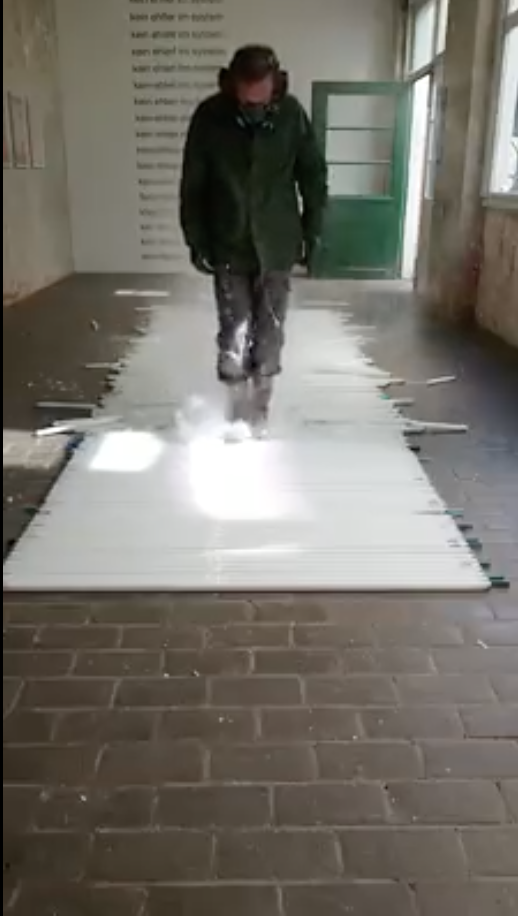
Walk Through a Line of Neon Lights (2019)
Watch here
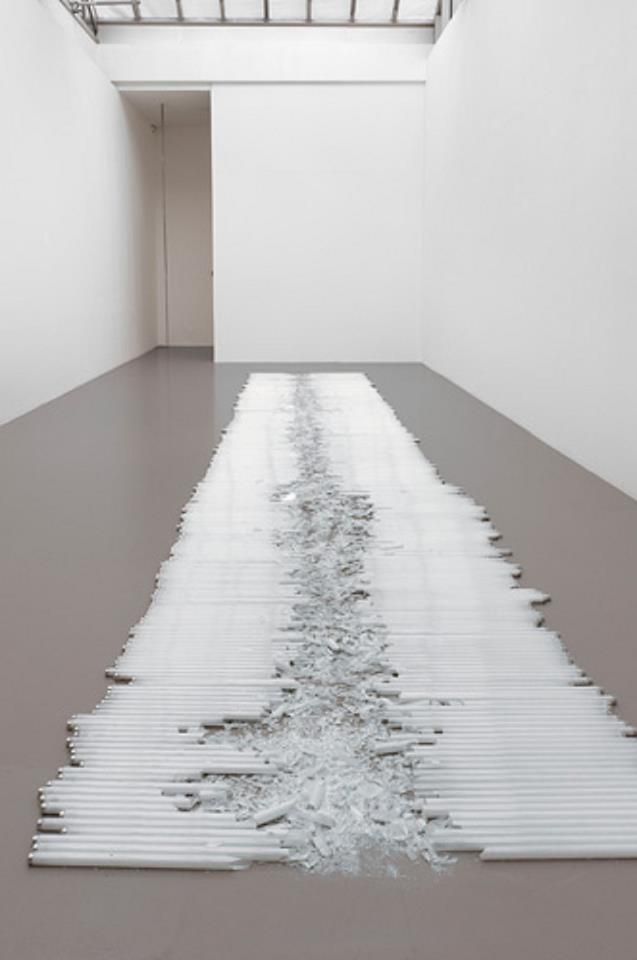
_________
Keith Sonnier
‘Employing unusual materials that had never before been used, Sonnier, along with his contemporaries, Bruce Nauman, Richard Tuttle, Eva Hesse, Richard Serra, and Barry Le Va, called all previous conceptions of sculpture into question. Sonnier has experimented with materials as varied as latex, satin, bamboo, found objects, satellite transmitters, and video. In 1968, the artist began working with neon, which quickly became a defining element of his work. The linear quality of neon allows Sonnier to draw in space with light and color, while the diffuseness of the light enables his work to interact on various architectural planes.’
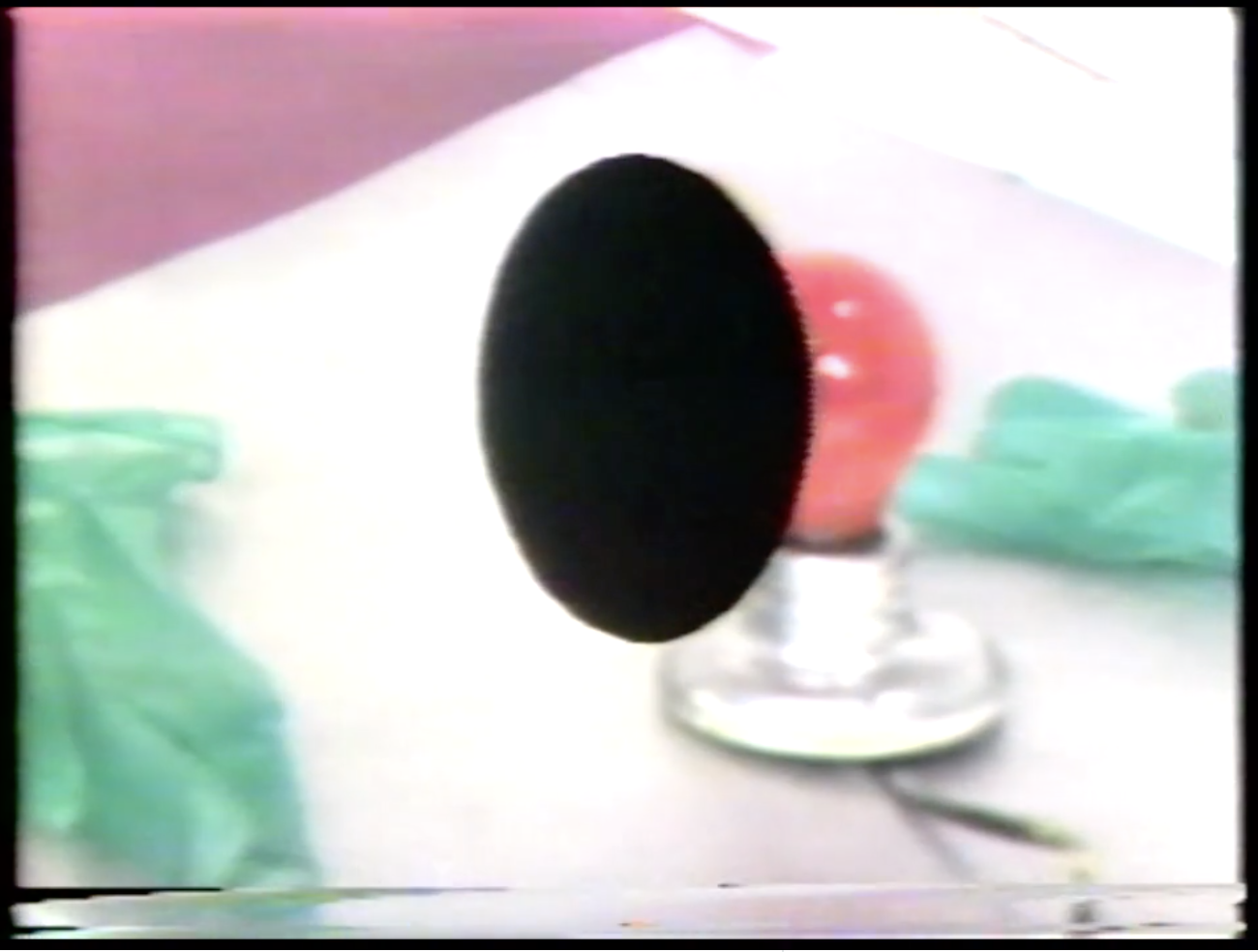
Mat Key and Radio Track (1972)
Watch it here
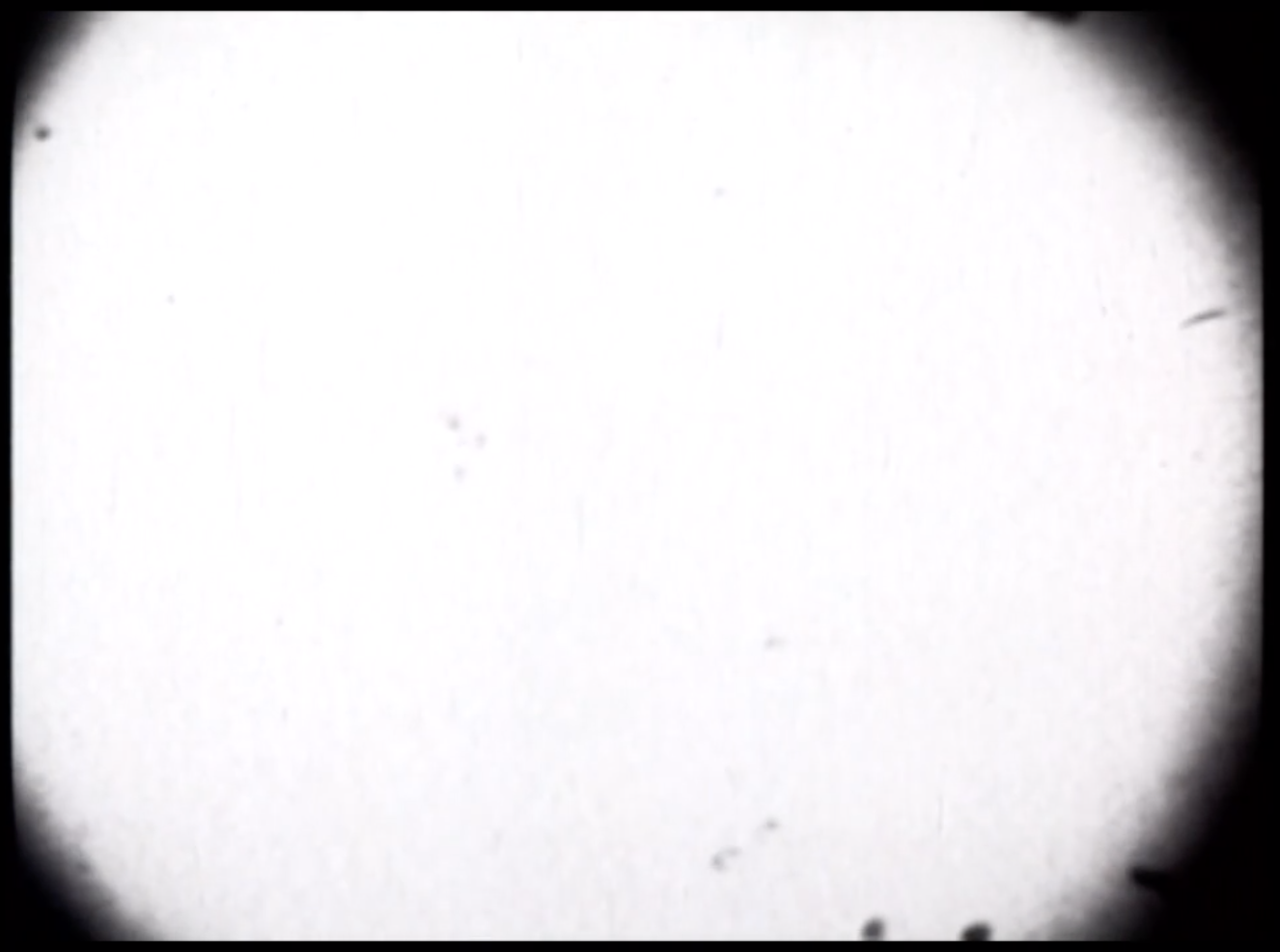
Lightbulb and Fire (1970)
Watch it here
________
Meghan Young
‘The Symphony in D Minor installation manages to capture the raw beauty of a thunderstorm in four cylindrical sculptures suspended 40 feet from the ceiling. Displaying rain drops and dark clouds, the imagery and sound is intensified when the installation detects movement. As soon as a person touches the sculptures, all hell breaks loose. Projections of rain and electrical charges are sent through the space.’
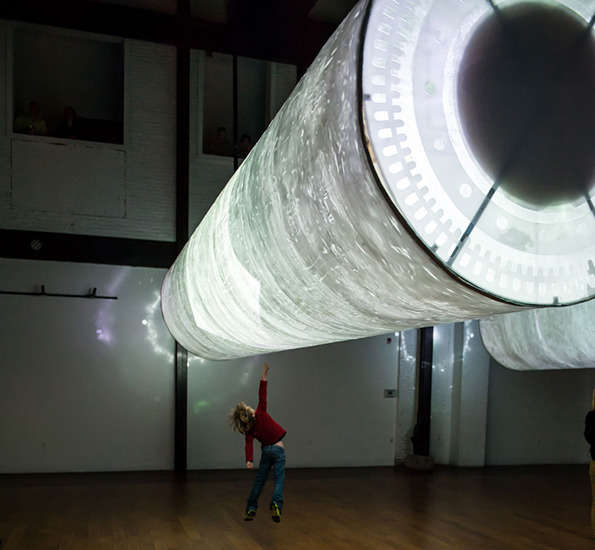
Symphony in D Minor (2012)
__________
Leo Villareal
‘Leo Villareal works with pixels and binary code to create complex, rhythmic compositions in light. Firmly rooted in abstraction, his approach uses layered sequencing that results in open-ended and subjective visual experiences. Villareal’s works often reference organic systems and evoke—but do not illustrate—atmospheric elements in that emergent and unexpected behavior occurs without a predetermined outcome. Interested in identifying the rules and governing structures of systems, Villareal uses custom, artist-created code to constantly change the frequency, intensity, and patterning of LED lights. For Villareal, the essence and medium of his work is code; light and its phenomenological effect is its visible manifestation.’
Cylinder 2 (2012)
Double Scramble (2014)
Cosmos 4 (2013)
Cylinder (2013)
________
Paul Chan
‘Chan described the series The 7 Lights (2005-07) as “hallucinating the seven days of creation from dawn to dusk”. His projections included visions of floating objects and falling bodies that drew on themes of the Apocalypse and Revelation, as well as referencing images and events from our contemporary world. The exhibition title referred to light, and in particular to light that had been ‘struck out’. The tension between the two is central to the artist’s practice.’
1st Light (2007)
________
Bruce Nauman
‘Nauman enforces the contrast between the perceptual and physical experience of space in his sculptures and installations. Looking at the brilliant color emanating from Green Light Corridor (1970) prompts quite a different phenomenological experience than does maneuvering through its narrow confines.’

Green Light Corridor (1970)
_______
Kyle McDonald & Jonas Jongejan
‘Kyle McDonald and Jonas Jongejan filled a darkened room with fifty disco balls and created colored and timed lighting sequences to cast mesmerizing reflections that surround visitors. However, rather than simply relying on scattershot reflections, McDonald and Jongejan used hundreds of structured light scans to capture the volumetric position of every pixel being projected by each of the three projectors. The pair then used SketchUp to predict the reflected pixel positions.’
Light Leaks (2014)
______
Unknown
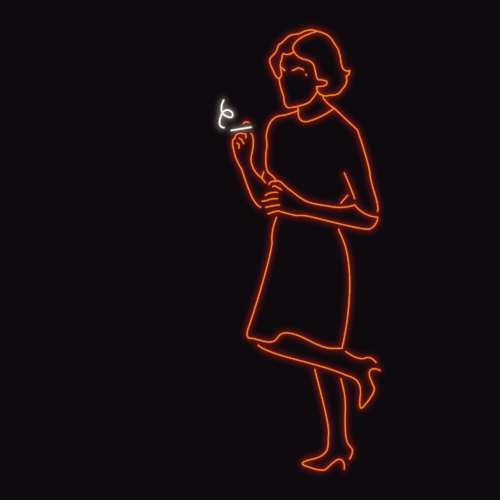
Town Without Pity/Audrey Horne (2013)
_______
Mona Hatoum
‘Home consists of a long table covered with gleaming metal kitchen appliances. The table has a polished wooden top and heavy metal legs on wheels. The industrial connotations of the table are offset by the domestic kitchen utensils on its surface, including graters, scissors, a colander, a whisk, a ladle, salad servers, a sieve, a pasta maker, presses and a heart-shaped pastry cutter. Wires snake through the installation, connected to each utensil with crocodile clips. The wires conduct electrical currents to the objects periodically illuminating small light bulbs positioned beneath the sieve and colander and inside an upright grater. The current is controlled by a software programme that alters the frequency and intensity of the lights. Speakers amplify the crackling sound of electricity coursing through the wires and the metal objects. The sculpture is set back behind a barrier of thin horizontal steel wires that separates the viewer from the potentially lethal current.’
Home (1999)
___________
Erwin Redl
‘Erwin Redl, an Austrian-born artist based in Bowling Green, Ohio and New York City, is best known for large-scale light installations for art museums, public buildings and corporations. His work transforms the medium of light into immersive, tangible experiences for viewers. His architectural environments translate complex mathematical algorithms and other methods inspired by computer code into contemplative, minimalist spaces further activated by his use of motion and rhythmic sequencing.’
Ascension (line 24), 2014
___________
Atsuko Tanaka
‘Atsuko Tanaka, (born Feb. 10, 1932, Osaka, Japan—died Dec. 3, 2005, near Nara, Japan), Japanese artist who , was a leading avante-garde artist, best known for her experimental works of the 1950s and ’60s. Tanaka was an early member of Gutai, a radical group of Osaka-based artists founded in 1954. Many of Tanaka’s works involved electric light, the most famous of which, Electric Dress (1956), was made entirely of coloured light bulbs, cords, and fluorescent tubes that she wore as a dress during performances.’
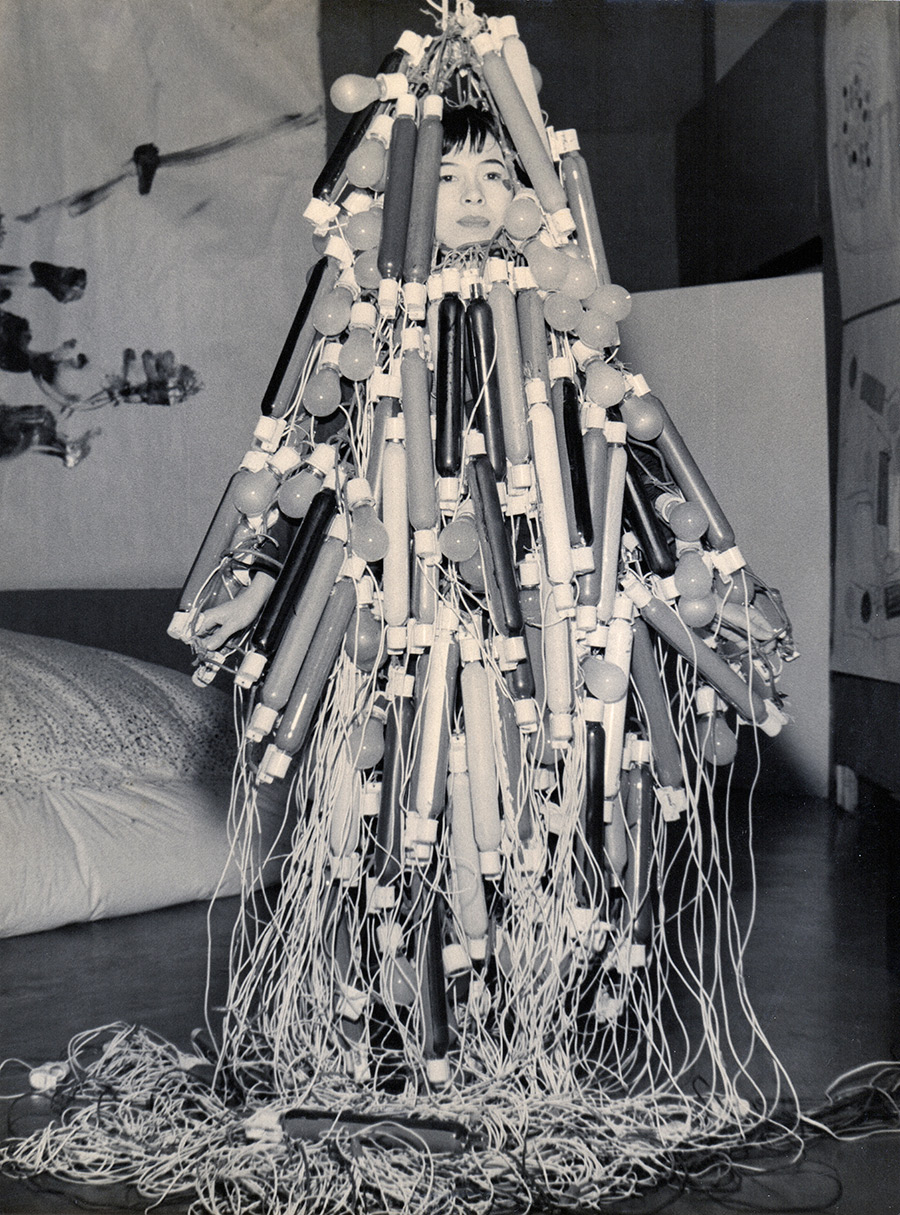
Electric Dress (1956)
___________
Daniel Rozin
‘Israeli-American artist Daniel Rozin (previously) creates performative objects that interact with the audience through mirroring. In his recent piece Cracked Mud (2019), a mound of clay pieces undulate and upturn in response to visitors’ movements below a low-hanging orb. The suspended light mimics the sun, hovering over the manipulated and cracked earth below. Another piece, Fabric Mirror (2019), uses a digital camera and 400 motors to capture the movements of those who walk past, imitating their gestures in twisting gold and red fabric. Both works allude to how the sun interacts with our bodies and the earth, the former representing a barren future, while the later explores our reflection bathed in shimmering gold.’
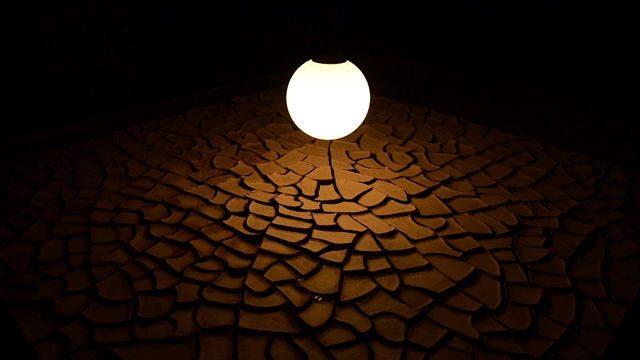
Cracked Mud (2019)
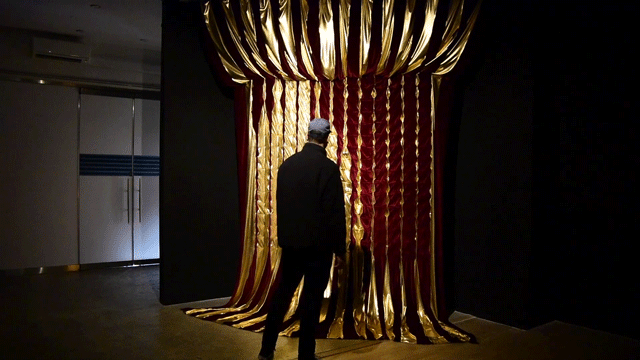
Fabric Mirror (2019)
___________
Jason Ferguson
‘Domestic Carnival is an ongoing project that takes the specific rooms of a home and re-presents them as flashing amusement park rides, transforming intimate interior spaces into objects of mass spectacle. Within the room dark and foreboding music, two hundred pulsing lights, steel joists, and a trailer combine with a dining room table, chairs, and oak hardwood flooring to create a carnival that is both familiar and uncanny. The apparatus is engineered like a carnival ride; the entire sculpture is mounted on a custom trailer that collapses for transportation to its next destination.’
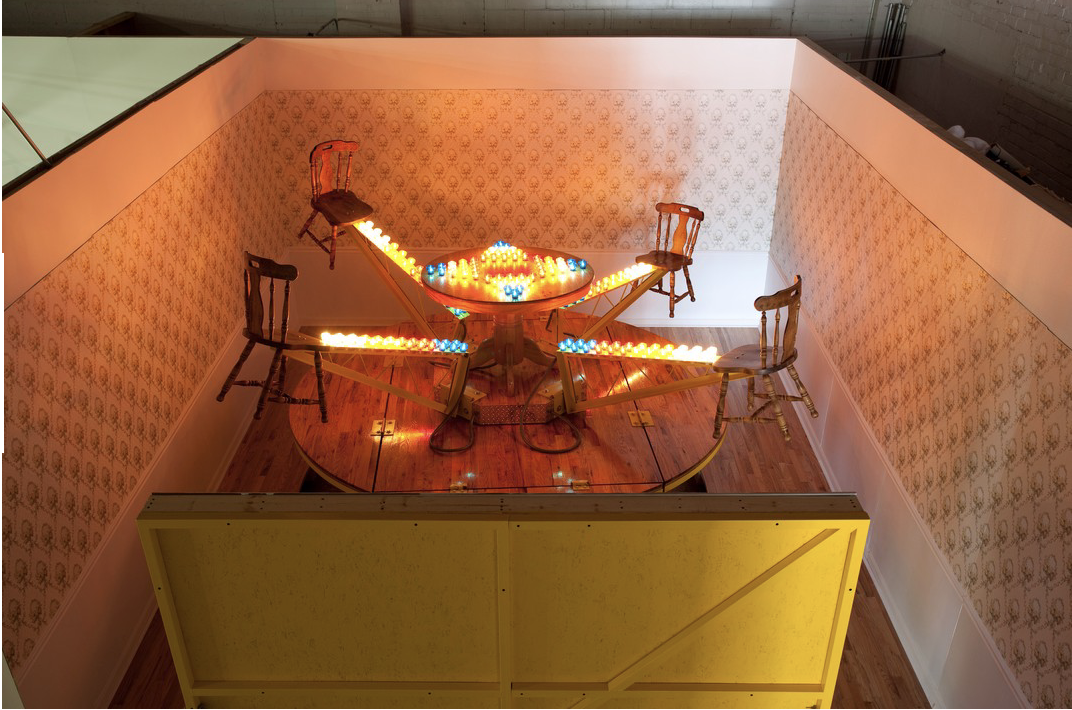
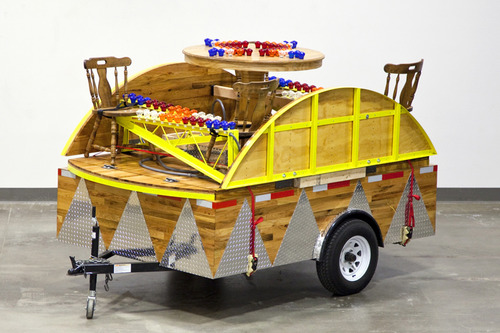
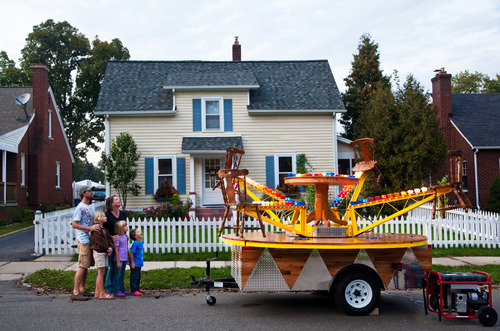
Domestic Carnival: Dining Room (2019)
________
Dan Flavin
‘In 1963, Dan Flavin began working with the medium of light: functional fluorescent tubes exhibited in their original state, without alteration or decoration.’
Demo for Installation of LED tubes
_______
Sherrie Levine
‘Cast stainless steel. “I want to put a picture on top of a picture,” Levine says. “This makes for times when both disappear and other times when they’re both visible.”’

Light Bulb (2000)
_______
Ed Atkins
‘Atkins is best known for works like Ribbons (2014), featuring iterations of drunken, soliloquy-spouting male protagonists who ruminate on perennial (and currently unfashionable) topics like love, loss, and loneliness. His work Even Pricks (2013) takes a slightly different tack. Atkins evokes his signature mood of quiet desperation with comparably spare methods, stringing together a series of vignettes that seem as indebted to the trippy avant-garde films of the 1960s as they do video-game cutscenes and contemporary cinematic tropes.’
Even Pricks (2013)
________
TUNDRA
‘TUNDRA is a St.Petersburg based collaborative artist collective focused on creating spaces and experiences by exploring facets of interaction between audio/visual and human emotions. We specialise in multi-media performances and immersive audiovisual installations. Our multidisciplinary team involves musicians, sound engineers, programmers and visual artists. The team is known for works presented at festivals and museums of multi-media art in America, Europe, Russia, and Asia.’
Row (2020)
THE DAY WE LEFT FIELD (2019)
Nomad (2018)
TUNDRA x JAGUAR (2018)
________
Otto Piene
‘In 1957, Piene developed the Grid Picture, a type of stencilled painting made from half-tone screens with regularly arranged points in single colors (yellow, silver, white, or gold), for example Pure Energy (1958, New York, MOMA). Piene’s work then developed in a variety of forms. The Lichtballette (“light ballet”, 1959) was a development of the Grid Pictures; light from moving lamps was projected through grids, thus extending and stimulating the viewer’s perception of space.’
Light Ballet (1969)
_________
David Batchelor
‘Batchelor is interested in the colours that you find rather than the ones that you make. So he’s been picking up discarded light boxes that typically advertise shops and restaurants (and that, he says, are one of the main sources of colour in a city), cleaned them up and mounted them to form a tall sculpture he called Magic Hour. The colours emanating from the light boxes are glowing against the wall and the public only see their reflection shining back at them.’

Magic Hour (2004-2007)
________
Leo Pyrata



_____________
Diana Thater
‘Featuring honeybees and a hive made of multicolored hexagons, knots + surfaces addresses a recent mathematical hypothesis that correlates a six-dimensional spatial model to the map of a honeybee’s dance. I’m working with animals that exist as individuals and as part of a complex social network that functions as a unit. Here, I feature the erasure of the video rectangle in order to create a multipart, puzzle-like image. Initially, the many components seem to form a single picture. However, when viewers walk into the projections, they penetrate the “bee space”; the one picture breaks into five and the surrounding bees become a vision of chaos.’

Knots + Surfaces (2001)
________
Larry Bell
‘One of the most significant artists of his generation, Larry Bell (b. 1939, Chicago) is an important representative of a West Coast minimalism that uses commercial and industrial materials and forms to create intense sensorial experiences. Best known for minimalist sculptures—transparent cubes and sprawling glass installations that thrive on the interplay of shape, light, and environment—Bell is considered a champion of the ideas of the Light and Space Movement of the 1960s. For decades, Bell has explored the new materials and modes of production developed by the military. His work during and after this period also reflects an interest in the scientific and technological experimentation taking place in Southern California. Hydrolux (1986) is complex fountain with live video projects, the work skews perception and critically invokes the viewer. As Bell’s only water-based sculpture that was executed beyond the model stage, Hydrolux demonstrates Bell’s constant inquiry into innovation, audience engagement, the surreal, and the sublime.’
Hydro lux (1986)
_______
James Clar
‘James Clar is a media artist whose work is a fusion of technology, popular culture, and visual information. Actually, his work is an analysis and observation on the affects of media and technology on our perception of culture, nationality, and identity. His interest is in new technology and production processes, using them as a medium, while analyzing and critiquing their modifying affects on human behavior.’
Cube-a-tron (2007)
Line (2004)
Flexogrid (2008)
Dynomite (2006)
_______
Kitty Kraus
‘The inherent fragility of Kraus’s mediums betrays established ideas about the stability and longevity of sculptural form. Such flaws are seen in Untitled (2006), in which illuminated lightbulbs are frozen inside ink-dyed ice cubes. Installed in the gallery at room temperature, the ice slowly melts, producing a meandering puddle of watered-down ink on the gallery floor, eventually leaving behind a stained and patterned path of dried ink.’
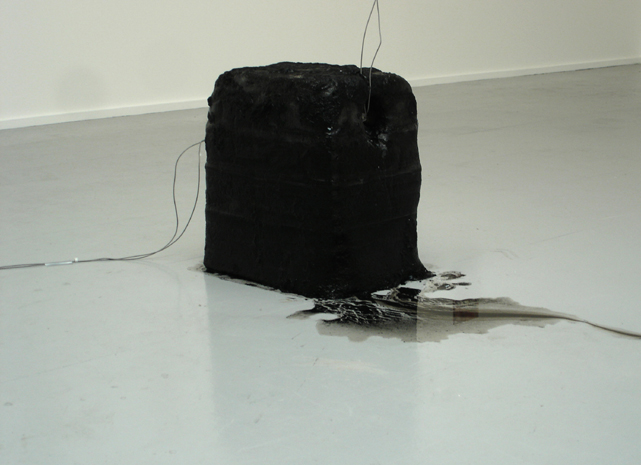

Untitled (2006)
_______
Chris Fraser
‘In response to rapid demographic changes in the Mid-Market neighborhood of San Francisco, I created an interactive environment made of pivoting doors. I wanted the space to embody the uncertainty of a city in transition, a city of competing desires, a city that erases and renews. The arrangement of the space enforced a certain civility. Alone, a visitor could open the doors with abandon. With a friend, they could collaborate. But in a group, one had to navigate the space carefully to avoid harming a neighbor.’
Revolving Doors (2015)
_______
Jumaadi
‘The play entitled “The Well and the Gold Nugget” is inspired and brings to life the true story of villages in Sidoarjo, East Java swallowed by mud. Homes, places of worship, schools, playgrounds, small rivers, rice fields, historic sites and thousands of memories were buried forever. Many varieties of indigenous plants and animals also became extinct. Community social structures broke down and villagers lost trust among themselves, particularly over the issue of compensation for their loss. This incident – which occurred on a mythical scale in 2006 – was the result of a technical fault by the mining company which to date has yet to find a way to stop the never-ending flow of mud.’
The Well and the Gold Nugget (2018)
*
p.s. Hey. ** Ian, Hi, Ian. If our heatwave has actually broken, and it’s still too early in the day to know for sure, things will be well in Paris. Camping/ canoeing sounds awfully nice. Does fantasy baseball involve pitting actual real existing teams against each other, or do you construct your ideal fantasy team, or … I’ve heard of it, but, obviously, I don’t know what it is. Congrats on the win in any case. I have not read those Paglia essays you mention. I’ll try to find them. I’ve only read a bit of her, and honestly I wasn’t so into her thing, but it’s been ages. Thanks! Enjoy whatever your day offers. ** David Ehrenstein, Hi. Really intense is really good, obviously. ** Sypha, Hi. Yeah, I may well have done a post about her and our relationship a long time ago. Huh. Different kind of blog back then. Oh, Tibet edited a lit. anthology? That’s curious. Yeah, I need to order the Finbow. Oh, god, the 1989 edition. The worst book cover I ever was saddled with in all of my publishing history. I was almost in shock when they first showed it to me. ** Derek McCormack, Ha ha ha, hi, Derek! Love, me. ** Misanthrope, Hi. Blake went through a bunch of very difficult real life stuff for a while, but I think he’s back to being as fine as he can be. Wow, well, I hope David continues to like the job, and, more importantly, that the job continues to like him. Ugh, man, on the computer death. Hang in there with your phone until tomorrow then. ** JoeM, Hi. Well, if it’s the pic at the top of the entry about his book, then yes, it is. Maybe you should read his book and find what’s going inside that face you like. I’m imagining that you’ve gotten into all kinds of arguments with all kinds of people, no? ** _Black_Acrylic, Yay, excitement creation! The ultimate achievement of which humans and their blogs are capable! Nice landlord, good. I think our heat has broken, at least a fair amount, although it still feels pretty muggy. I hope the big storm that came through here last night to try to kill the monster went through Leeds and had at least the degree of success it seems to have had here. ** Quinn R, Hi, Quinn! ‘Alice Knott’ is great. I love all of his work. He has in the past popped in here occasionally to comment, but he was never a super regular or anything. Oh, gosh, I don’t know about sending Bill Clegg your story. I’m completely inexperienced with that kind of thing. With both of my agents, I just ended up in their laps, as it were. You should probably ask writer friends who’ve been in the situation of seeking an agent. It doesn’t seem like an overly savvy/ confident move to me. I think maybe one gets more pragmatic about compliments as you get older. You’re able to gauge what they actually imply and mean better, and your confidence will continually rise. I’m someone who’s been very pragmatic about compliments pretty much my whole life. They mean a lot, but I’m wary of taking them to heart since people say and like what they do for mysterious and sometimes complicated and even selfish reasons — and the very same goes for negative criticism — and I’m always wary of second guessing people. So, yeah, I think you should fully enjoy the affirmations because you inspired them no matter where they’re coming from. I guess maybe just try not to fantasise about what they’ll lead to or something? I don’t know. It’s complicated but, yes, absolutely enjoy them. I’ll be interested to read your book review. You’ll alert everybody when it’s up? Hm, I wrote some pretty negative reviews back when I was writing reviews, and of queer books too, and, yeah, there were people involved with said books who were not happy. But some people not liking you is part of the deal. I wrote a quite negative review ages ago of ‘The Violet Quill Reader’, or whatever it was called, and that review got much blowback. Felice Picano permanently stopped talking to me. But, at the time, there was this move to create a gay lit. hierarchy where the ‘Violet Quill’ were positioned as the greats, and I really hate hierarchies, so my ire was more about that positioning than the writers, although I think I was kind of snarky about the writers in that review too. I don’t regret publishing it. And if it had a tiny part in the ultimate derailing that attempt to make the ‘Violet Quill’ a kind of gay lit Olympus, I think it was worth it. Anyway, blah blah, I wouldn’t worry. There are those, and maybe even many more of those, who respect when a writer throws caution aside and speaks his or her or their truth. I do, even if I don’t personally agree with the writer’s assessment. My novel is just sitting and waiting for its release date to be scheduled. Still working on fund-raising for the new film, and some interesting possibilities are out there. The main thing I’ve been working on is trying to turn the script of the doomed TV series project into a script for a feature film for Gisele to direct. And I’m pretty happy with how that’s turning out so far. We’ll see. Anything you’re working on that’s exciting you? ** Bill, Wow, ‘The Hole’. I really liked that film. It’s been years. It holds up well, huh? That would be a fun rewatch. What’s in-progress in and around you? ** Steve Erickson, Hi. Ah, that makes sense. Everyone, Mr. Erickson has finished a new music track that is now available for your streaming pleasure. In Steve’s words: ‘I finished “PAW (Cult of the Gish Gallop)” today. I had to put it through a filter to control the distortion, but that also toned its dynamics way down and made it sound fairly quiet. Here ’tis‘. It’s so cool you’re working with Ira Robbins. I hope he loves the interview. ** Okay. Get lit. See you tomorrow.




 Now available in North America
Now available in North America 
‘I’m imagining that you’ve gotten into all kinds of arguments with all kinds of people, no? ‘
Absolutetly.
As you well know!
But we’re still friends.
Dennis, Lighting is so important. And lack thereof. Kinda the same with white space in a piece of lit, as well as what you say versus what you don’t say. Good stuff.
Yeah, David’s doing all right so far. I think he’s gonna be okay.
This computer-less hell is hellish, hahaha. Just glad I saved all my writing regularly. Would’ve been kinda suicidal if I’d lost all that, especially the novels I’ve worked on. Ugh, just the though lt makes me crazy.
Ooooh I love Electric Dress! Your blog posts are everything. Do you think perhaps one day it would be possible to somehow publish your old blog or at least bits of it? I adore your current blog, but whenever I see references to your ‘old blog’ I can’t help but feel I’ve missed out on something really beautiful and integral to the DC archive. Or perhaps I imagined the whole old blog saga? But if I got it right, it was much more diaristic than your current one? Anyway, I hope this wasn’t insensitive of me to ask, just interested to read more from you xoxo
“She almost looks human / It must be thelighting” — Sondheim
This was actually the 2nd book Tibet has edited. A few years ago he did one called THE MOONS AT YOUR DOOR that was a similar collection of horror/supernatural stories that had influenced him and Current 93 throughout his life. I like the series but they are very old-fashioned, I think Ligotti is the only modern/living author to appear in any of them.
“The worst book cover I ever was saddled with in all of my publishing history.”
I know when I saw it I thought, “H’mm, this doesn’t look like the kind of cover Dennis would have liked.” But personally I still think it’s better than the MY LOOSE THREAD paperback cover, which I also remember you griping about to me once way back in the day, ha ha. Anyway I think all that I’m missing now is THE TERROR OF EARRINGS, TIGER BEAT, ANTOINE MONNIER, MY MARK, THE MISSING MEN, JERK, and ALL EARS. There might be a few other ones that escape my mind…
Your words are always too kind. I love these curatorial posts and the things they bring up for me. Today it’s Rich Jensen (https://youtu.be/AACJ_Pd6L68) reading in an installation I did in a garage in Marfa (https://1.bp.blogspot.com/_t_Q8LzobRfM/R7rt2ZmoH_I/AAAAAAAAAi0/lCz2rsnDGGY/s1600/IMG_0207.JPG), Iñigo Manglano-Ovalle’s ‘The Radio’ (https://www.galeriethomasschulte.de/exhibition/the-radio/), Anthony McCall, James Turrell, and too much recent bad neon queer art. The past five months have allowed me to rediscover my three favorite pastimes — jogging, playing guitar, and reading gay coming-of-age novels (now on Giorno’s memoir)
I found this artwork by Jim Lambie – Cigarette burns, 2000. Was looking for a video he made called Ultralow from 1998 that shows flickerings of cigarette butts in a pitch-black basement, but no evidence of that can be found online sadly.
Things were much more friendly with the weather today, so I was able to get upstairs to the attic and record episode 3 of my Play Therapy radio show. That’s broadcast next week but it’s good to have things wrapped up ahead of this weekend’s Dundee upheaval.
The idea that the Violet Quill guys were the most interesting gay writers even of that period seems really dated. But their self-importance also feels like a product of a time when literature was the main way gay identity was expressed in the arts i the US. It felt to me like that period persisted till New Queer Cinema.
Robbins has acknowledged receiving the interview, but if he’s read it, he hasn’t gotten back to me yet. The Other Music directors also made a film on the soul singer Syl Johnson which has gone unreleased due to music clearance issues.
I really liked one of Bandcamp’s front-page recommendations today: the harsh and nasty-sounding Kenyan industrial/metal band Duma.
‘Friends that can’t argue are either barely friends or really good friend’s’.
Well I think we’re in the latter category. Boy, have we argued over the years and almost decades!
Also me and ‘Misanthrope’ (That always seems so weird to me).